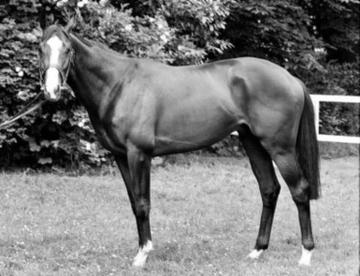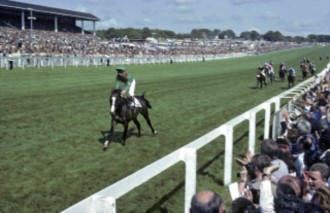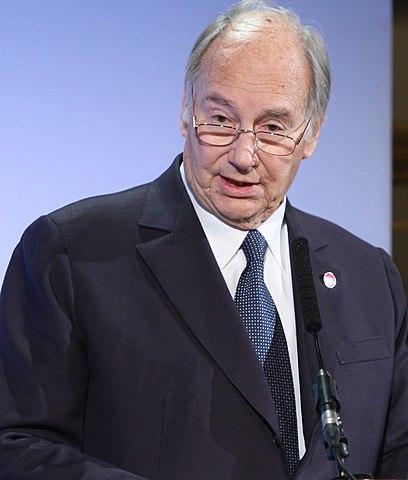On February 8, 1983, the world of sports was left dismayed and bewildered when one of its greatest champions, Shergar, was kidnapped by a group of masked men armed with machine guns from his farm in Ireland. A ransom demand soon followed the kidnapping, but before anyone could pay up, the criminals cut off all communications.
It has long been speculated that Shergar resisted his captors and was killed during the struggle. Once the criminals lost their meal ticket, they tried to erase all signs of what had happened and completely distance themselves from the botched kidnapping. We say “speculated” because the remains of Shergar were never found and the identities of his killers were never discovered. The true fate of this champion racer remains a mystery to this day. And, oh yeah, in case we forgot to mention it, Shergar was a horse…
A Champ Is Born
Let’s start off with the elephant in the room, so to speak. Shergar, our subject for today, was not a human. He was a horse, but not just any horse. He was a Thoroughbred racer widely considered one of the best of all time, and who still holds the record for the biggest winning margin at the Epsom Derby, arguably the most prestigious horse race in Britain.
Shergar was born (or foaled, to use the correct term) on March 3, 1978, at the Sheshoon stud farm in County Kildare, Ireland. The owner of the stud was Aga Khan IV, the Islamic leader and business magnate. Like us, we are going to assume that most of you haven’t done a lot of horse breeding in your lifetimes, so we will keep you up-to-date with all the fancy pants jargon. Physically, Shergar was described as having a bay color (aka a reddish-brown with a black mane and tail) with white socks on his legs and a white stripe on his face called a blaze.
When it comes to racehorses, their pedigree is very important, so we can actually trace Shergar’s lineage with a lot more accuracy than a lot of human subjects we have covered here on Biographics. Both his parents were champion racers. His mom, who is called a dam, was Sharmeen, while his father, also known as a sire, was called Great Nephew.

Even as a foal, Shergar showed great promise, so he was sent to England for training when he became a yearling, aka a young horse between one and two years old. Once he passed the age of two, he became a colt, unless he was castrated, in which case he would have been a gelding. Shergar’s trainer was Sir Michael Stoute, one of the best in the biz, and he recalled that the horse displayed a gentle temperament and he responded well to training.
In 1980, it was time for Shergar to make his racing debut. It was September, and the race was the 1600-meter Kris Plate at Newbury. For a jockey, the Aga Khan spared no expense – he hired Leslie Piggott, one of the most successful riders in the country. It was a dominating debut for Shergar, as the horse won the race by two-and-a-half lengths – a length being a common unit of distance used in racing, defined as the average length of a horse from nose to tail, or approximately 2.5 meters.
Right off the bat, everybody was impressed with Shergar’s performance and there was an immediate feeling that they had something special on their hands. The horse only had one more race in 1980, the 1600-meter Futurity Stakes at Doncaster. Again, Shergar performed well, but he actually came in second this time. Even so, the team still accomplished its goals of giving Shergar some valuable experience and creating a lot of positive buzz around him. Now it was time to give him a little rest and start preparing for the next season, where Shergar would take the racing world by storm.
The Champ Is Here
With the start of a new year came the start of a new racing season and Shergar was already branded as the one to watch. Suffice to say that he did not disappoint. His first race was the 2000-meter Guardian Classic Trial in April and he took home first place, ridden by a new jockey named Walter Swinburn. This was quickly followed by another victory the following month at the 2400-meter Chester Vase, showing to the world that Shergar had stamina and consistency, as well, not just speed.
But then came the race that propelled Shergar into superstardom – the Derby Stakes, also known as the Epsom Derby, one of the most important races in the world. Shergar not only won the race, but he dominated it, finishing by ten lengths ahead of second place, a record in the derby’s 240-year-old history that still stands today. Just like that, Shergar became the most valuable horse in the world, worth an estimated $15-to-16 million, which would be around $45-to-48 million today.
And he showed no signs of slowing down because less than a month after coming in first in England’s most prestigious race, he traveled to Ireland where he did the same thing by winning the Irish Derby. And after that came the “King George,” another one of England’s premier horse races.
All of this was building up to Shergar competing in the Prix de l’Arc de Triomphe in France, simply known as the “Arc,” which is widely regarded as the most esteemed race in Europe. It is open to horses of all ages and would have been the perfect way to cap off what, up to that point, had been one of the greatest and most profitable seasons in horse racing history. However, that race was still two-and-a-half months away following the “King George” and Shergar’s team decided that it was too long to wait, so they entered him in another race in early September to keep up his momentum.

It was the St Leger Stakes in Doncaster and, at a length of 2,800 meters, it was the longest race that Shergar had ever competed in and it ended in a massive disappointment. Like with most of his other races, the horse stayed close to the frontrunners for most of the event. In all the other ones, however, Shergar would always overtake on the final straight and win the race. This time, he simply…didn’t and ended in a decidedly mediocre 4th place, finishing 11-and-a-half lengths behind the winner.
Nobody was really sure what had happened. Extensive tests showed that Shergar was not injured or in poor health, but that 4th place scared his team enough that they not only pulled him out of the Arc but they retired him completely, putting an end to Shergar’s racing career after only eight competitions.
Not that his owner was too broken up over the decision since he had already made back his investment several times over. Following Shergar’s commanding victory at the Epsom Derby, the Aga Khan received multiple offers to sell his prized horse. Instead, he decided to syndicate Shergar, creating 40 shares worth about $400,000 each in 1982 money. He kept six shares for himself and sold the rest to individual buyers.
As far as Shergar was concerned, he was retired to stud at Ballymany farm, in Newbridge, County Kildare, Ireland. He had put in the work and now was supposed to reap the benefits as a life of leisure awaited him, not to mention that he was going to get freaky with dozens of mares in order to sire the next generation of champions. Or, at least, that’s what everyone hoped would happen, but that’s not exactly how things played out.
The Kidnapping
At first, things went pretty well for the retired champ. Shergar got to enjoy one full rutting season during which he bred (or covered, to use the correct lingo) over 40 mares and produced 35 offspring. None of them, however, ended up holding a candle to dear ol’ dad, and Shergar’s only foal that achieved some notable racing success was a stallion named Authaal, who won the Irish St. Leger, among a few other races. Nobody knew that yet, of course, so Shergar’s services were still very much in demand, and his 1983 stud season was fully booked with even more mares than his first.
But then, on February 8, 1983, the unthinkable happened. It was around 8:30 pm and the head groom at Ballymany Stud, Jim Fitzgerald, had retired for the day and was resting alongside his wife and five children in his home located on the stable grounds when he heard a loud knock at the door. His son, Bernard, answered the door and was greeted by two masked men waving around machine guns.
Immediately, it became clear what they were there for, even without a single word being spoken. After all, there was only one thing of real value at the farm – Shergar. As a few other gunmen made their way into the house, one of the original two collected Fitzgerald’s entire family and locked them inside a room, while the other one demanded that the groom take him to Shergar.
Fitzgerald was hardly in a position to negotiate – he was outmanned, outgunned, and the criminals held his family at gunpoint. So he did as he was told and went to collect the horse. When he and Shergar were outside, the gunman he was with took out a walkie-talkie and had a horse trailer pull up. The groom couldn’t tell exactly how many criminals there were, but he guessed around half a dozen.
Both horse and caretaker quietly obeyed – Shergar went inside the trailer, while Fitzgerald put on a blindfold and was taken inside another car. The two vehicles departed and, just like that, the horsenapping was complete.
The cars drove around for hours. Finally, they stopped on some dusty road in the middle of nowhere and let Fitzgerald out. He was warned not to contact the police, otherwise, he and his family would be killed. They told him that the ransom demand to get Shergar back was £2 million, around $2.6 million, and gave him the code “King Neptune” to confirm their identities later when they would call.
As the cars drove off, Fitzgerald was left wandering the Irish countryside in the darkness, until he stumbled upon the town of Kilcock and found a phone. The threat against his family was still fresh in his mind, so the groom did not alert the police, but made the first call to his brother, who came and picked him up in a car and drove him back to the stables. Once Fitzgerald was sure that his family was safe, he called his boss, stud manager Ghislain Drion, who then tried to reach the Aga Khan in Switzerland. A few other people, including Shergar’s veterinarian, a finance minister, and an official with the Irish Thoroughbred Breeding Association were all apprised of what had happened, and none of them were really sure how to proceed. High-profile horsenappings were quite rare – the last one had occurred in 1977, when a mare named Fanfreluche was stolen from her paddock in Kentucky.
Eventually, one of them, we don’t know who, contacted the police and told them what had happened but, by then, the gunmen had at least a six-hour head start.
The Calls
The next day, local police started the search for Shergar, but the kidnappers had picked their opportunity very carefully. A big horse sale was taking place in the area that day, so there was a sea of horses and trailers everywhere. The criminals could have probably ridden Shergar down the street without anyone noticing them. Plus, from the very beginning, the investigation was hampered by the fact that multiple law enforcement agencies got involved and they didn’t play too nice with each other. It soon became evident that they had no choice but to wait for the ransom call.
It came the next evening. Ghislain Drion, the Ballymany manager, answered the call and, following instructions from the Garda (the Irish police service), he played dumb and stalled for time to keep the kidnappers on the line for 90 seconds in order to trace the call. However, it seems like the criminals had seen the same police movies as the rest of us, and were wise to the trick. They hung up the phone and called back several times to prevent a trace. Occasionally, the conversation turned into a surreal comedy sketch, as Drion, a Frenchman, struggled to understand the caller’s thick Irish accent, while the man on the other end had the same problem with his French accent. Eventually, the kidnappers got fed up with Drion and demanded to speak with the Aga Khan or someone in his inner circle, but they were all abroad.
At the same time, an even stranger episode was happening inside the BBC newsroom in Belfast, as they also received a call from someone purporting to be the abductors. The anonymous caller had a very bizarre and specific demand, insisting that he would only deal with three people – Lord Oaksey, Peter Campling, and Derek Thompson, all three of them horse racing journalists and pundits from London.
By that point, the whole world knew about the kidnapping of Shergar so, unsurprisingly, the journalists jumped at the opportunity to be part of one of the hottest stories of the year. Before you knew it, the three of them and a camera crew had flown to Belfast and checked in at the Europa Hotel, as per the caller’s instructions. There, another call came through, and the man instructed them to get rid of all the media that was following them around like a lost puppy and go to a secluded farm 30 miles from Belfast.

With a little help from the police, the three pundits managed to lose the local press by sneaking through the kitchen and out the service entrance into a waiting vehicle. They then sped off, not really knowing where they were supposed to go. Unsurprisingly, they got lost and were driving in the remote areas around Belfast when they were stopped by a group of five guys wearing balaclavas and wielding machine guns. First impressions suggested this was the same group of guys who kidnapped Shergar, but first impressions were deceiving because they were actually the police. They realized that the London boys probably got lost in the woods so they came to the rescue.
Eventually, everyone reached the farmhouse, so there was nothing else to do but wait for the call. Thompson would do the talking. He knew the score – keep them on the line for 90 seconds. When the first call came through, the kidnapper demanded an initial payment of £40,000, while the journalist insisted on proof that Shergar was still alive. They went back and forth like this over the course of about eight-to-ten calls, all of them ending around the 80-85-second mark. Then, it seemed like they finally struck gold with the last one. After eight hours of negotiations, it was one in the morning but Thompson managed to keep his conversation partner on the line for 95 seconds. He turned around with a look of hope and expectation at the police officer next to him, only to be told “I’m sorry Mr. Thompson, but the man who traces the calls went off-shift at midnight.”
So that was it. That angle of the investigation and Thompson’s involvement turned into a resounding dud, but what was all that malarkey about £40,000? Fitzgerald’s kidnappers told him they wanted £2 million. Forty thousand pounds was a drop in the bucket compared to what Shergar was worth. Nowadays, most people see this bit as a wild goose chase, but the question is – who was behind it? Was it just some random guy who got bored and thought he would try his luck, or was it the same people who actually kidnapped Shergar, working a second angle to confuse and preoccupy the police?
Negotiations Break Down
Running parallel to the strange episode involving the London journalists were the negotiations between the Aga Khan and the men who definitely kidnapped Shergar. But almost immediately, it became pretty clear that the criminals did not take into account the fact that the Aga Khan could not make unilateral decisions involving Shergar since he was just one of 36 owners now. This made the negotiations drag on for several days, as there was heavy disagreement within the syndicate regarding the best way to proceed. Some wanted to pay the money, thinking that it would still be a small sum compared to the profits Shergar could bring over years, even decades of breeding. Others steadfastly refused, fearing that, if they paid up, they might as well paint a giant red target on the back of every other horse in the world. Sure, others had been kidnapped before, but none of them were as valuable or as famous as Shergar, so if they caved in to ransom demands, they were declaring open season on other champion breeders.
Ultimately, though, the syndicate did not have to reach a decision because the kidnappers broke off contact before that could happen. After a few days of negotiations, the owners decided not to proceed any further unless they obtained some evidence that Shergar was still alive. On February 12, four days after the kidnapping, one of the abductors left evidence at the Rossnaree Hotel near Dublin, in the form of a package containing Polaroids of the horse, including some that displayed a newspaper from the previous day in the background.
For some reason, the pictures were all close-ups of Shergar’s head. This did not reassure the shareholders. If anything, it made them more suspicious. The horse in the Polaroids was definitely Shergar, but why would the kidnappers avoid showing the entire animal? That same night, the criminals called again with the same demands, but the syndicate rebuffed them, saying that the pictures were “not proof enough” of Shergar’s status. Clearly, this struck a nerve because the caller said “Well, if you are not satisfied, that’s it.” And then the line went dead.
And that was really it. Nobody ever heard from the kidnappers or Shergar again. The Irish police, led by Chief Superintendent Jim Murphy continued the investigation, of course, but they never made any serious headway and were skewered by the press. Murphy received the brunt of the mockery, often being compared to Inspector Clouseau or the Keystone Cops. For the media, the whole thing was like an all-you-can-eat buffet, and they gorged on every juicy little tidbit they uncovered – the crazier, the better. One story reported that the police turned to psychics and clairvoyants for help. Another claimed that Shergar was alive & well at a hippy commune somewhere in Ireland. Then another said that the horse had been stolen by the New Orleans mafia, or given to the Libyan leader, Muammar Gaddafi.
The madness went on for a few months before the public started getting bored and the media began looking for the next story to grab their attention. By that point, the affair was considered closed – Lloyd’s of London, the insurance company, paid out millions to the syndicate and the shareholders were resigned to the fact that Shergar was probably dead and that they would never see him again. Everyone involved was ready to move on with their lives, but this still left the lingering mystery of who kidnapped Shergar and what did they do with him?
At first, there was a wide range of suspects, including a rival horse breeder who was an enemy of the Aga Khan. However, as the years passed, all fingers seemed to point in just one direction – the Irish Republican Army, or IRA. Specifically, it was the Provisional IRA, the paramilitary group responsible for many of the violent events during the 30-year conflict known as the Troubles. During the early 1980s, they were hurting for money, and they had kidnapped people for ransoms before, so why not a horse?

This is the version accepted by the syndicate and the police, although no arrests were ever made in the case. The IRA itself never claimed responsibility, but several informants painted the picture of what had happened. The first was Sean O’Callaghan, who published his memoir on his time with the IRA in 1998. He claimed that Shergar had been killed less than 24 hours after being abducted because the kidnappers didn’t think to bring along someone who was actually trained and equipped to deal with a horse. Surprisingly enough, machine gun threats didn’t work as well on animals as they did on humans and Shergar injured himself after thrashing about in his trailer. This confirmed the suspicions of the syndicate all those years ago that the Polaroids of Shergar were all headshots because the horse was already dead at that point.
A different informant, who claimed to have witnessed the event, gave a much more brutal and violent description of Shergar’s final moments: “Shergar was machine-gunned to death. There was blood everywhere and the horse even slipped on his own blood. There was lots of cussing and swearing because the horse wouldn’t die. It was a very bloody death.”



